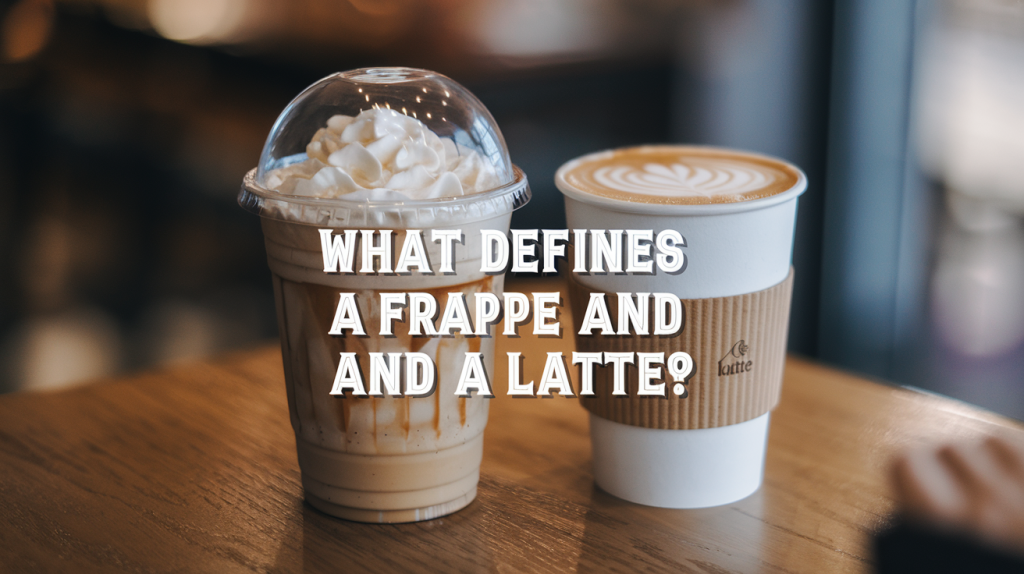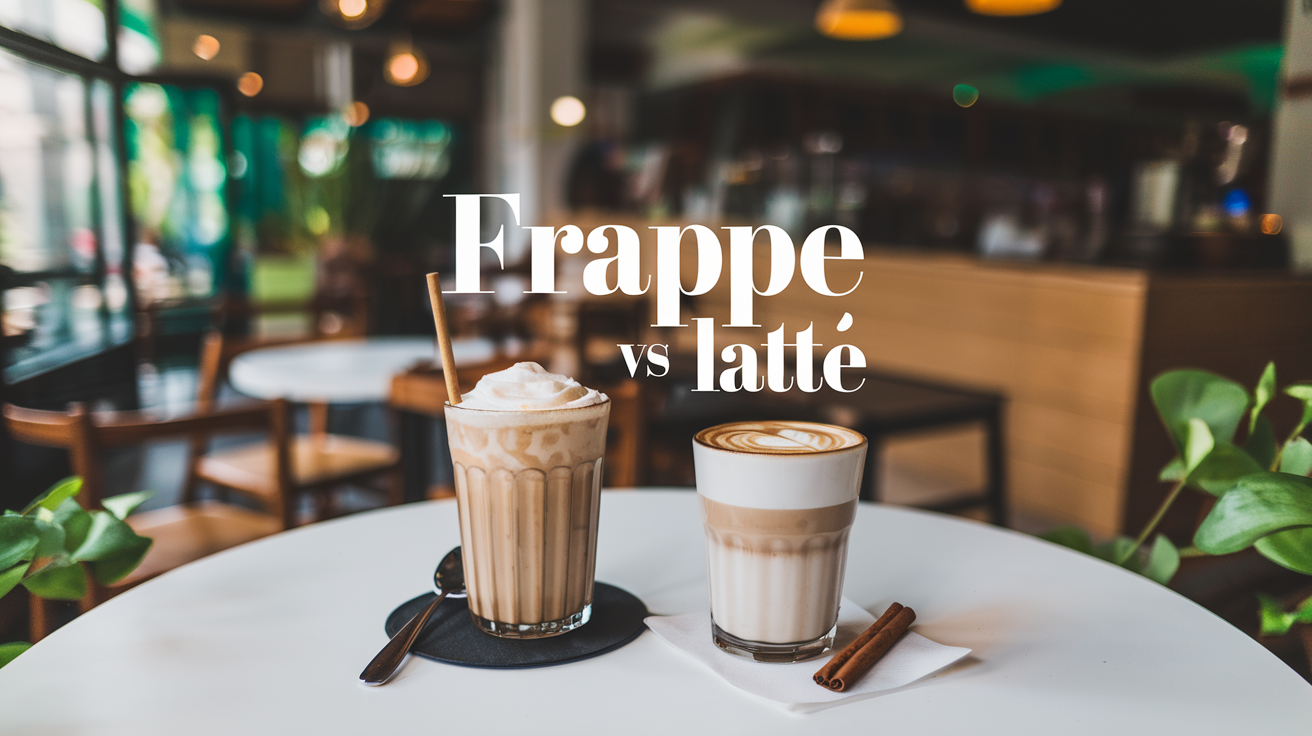Frappe Vs Latte: Understanding The Difference Between These Popular Coffee Drinks
Choosing between a frappe and a latte can be tricky. Both coffee drinks are popular, but they are quite different. You might wonder which one will suit your taste or give you that much-needed caffeine lift in the morning.
Here’s something to keep in mind: A frappe is an iced beverage, while a latte is served hot.
In this article, we’ll examine what makes each drink unique – from their ingredients to how they’re prepared. We’ll also review their caffeine content and how this affects their taste and texture.
You’ll learn about various flavours you can try and get some tips on making these delightful beverages at home. By the end of it, choosing between a frappe and a latte won’t just be easy – it’ll be exciting too.
Ready to find your new favourite?

What Defines a Frappe and a Latte?
A frappe is a cold drink made with ice, milk, sweeteners, and coffee. It first appeared in Greece in 1957. People blend it to create a frothy top. This makes it very enjoyable on hot days.
Frappes often come sweeter than other coffee drinks because of the added flavours.
A latte combines espresso shots with steamed milk. It’s famous in Italy for its creamy texture. Baristas pour the espresso into a cup first, then add the steamed milk gently. This process creates a smooth drink that highlights the strong flavour of the coffee beans used in making espresso shots.
Breaking Down Ingredients and Preparation Techniques
Frappe and latte are two popular coffee drinks with different ingredients and ways of making them. Here’s a detailed look at what goes into each one and how they’re prepared:
- Frappe starts with instant coffee, mixed with water, milk, sugar, and ice. You blend the instant coffee with a bit of cold water until it gets frothy. Then add sugar to taste; blend again. Next, mix in milk and pour over ice in a tall glass. Some people like topping it off with whipped cream or chocolate syrup for extra flavour.
- Latte involves ⅓ espresso and ⅔ steamed milk, finished with a thin layer of foam on top. You begin by brewing a strong shot of espresso using ground coffee in an espresso machine. Then heat the milk, using a steam wand to create that creamy foam everyone loves. Pour the hot espresso into a cup, followed by the steamed milk. For those skilled in latte art, now’s your chance to make a design on top.
- Variations play a big role in both drinks—you can personalise frappes with different syrups like caramel or vanilla for unique tastes. Adding whipped cream on top makes it even more indulgent.
- Lattes can be customised too; try using non-dairy milks such as oat milk or almond milk for plant-based versions. Experimenting with flavoured syrups and spices like cinnamon can also change up your latte game.
- Frappes can include ice cream blended into the mix for those wanting something closer to a delicious milkshake experience.
Quick tip: If you’re making these at home, keep in mind that the quality of your coffee matters—a good quality instant coffee will improve your frappe while freshly ground beans will make your latte taste better.
Each method shows how different ingredients and preparation techniques result in unique textures and flavours between frappe and latte drinks, letting you enjoy whichever suits your mood or preference at any time.

Comparing Caffeine Levels in Frappe and Latte
Let’s get straight to the point. You’re curious about the caffeine content in frappes and lattes. Here’s the lowdown:
| Coffee Type | Average Caffeine Content (12-ounce serving) |
|---|---|
| Frappe | 50 to 100 mg |
| Latte | 63 to 126 mg |
| Maximum Caffeine Content | Frappe up to 180 mg, Latte around 75 mg |
Lattes, on average, pack a bit more caffeine than frappes. However, some frappes might hit harder, reaching up to 180 mg. The key factors here? The type of coffee and how it’s made. Whether you’re brewing at home or ordering at your favourite cafe, this info guides your choice. Prefer a milder kick? Go frappe. Need a stronger boost? A latte’s your best bet. These numbers can vary. Coffee type and preparation play major roles. So next time you’re choosing between these two, you’ll know exactly what you’re getting into, caffeine-wise.
Analysing Taste and Texture Differences
A latte offers a smooth, velvety feel in your mouth. It blends hot coffee with steamed milk to create this creamy texture. Consider the taste of strong coffee mellowed down by the creaminess of milk.
This makes lattes warm and comforting, perfect for sipping slowly.
On the other hand, a frappe is like a cold dessert you can drink. It’s thick because it has ice blended into it, giving it a consistency similar to milkshakes. Frappes are sweeter and often come with whipped cream on top, adding to their indulgence.
Every sip is cool and refreshing, ideal for beating the heat or enjoying as a sweet treat anytime.
Exploring Popular Variations and Custom Flavours
Frappe and latte drinks can change a lot with different tastes and extras. You can pick from many flavours and milks to make your coffee just right.
- Chocolate frappe: Blends iced coffee with chocolate syrup, ice, and sometimes whipped cream on top. It’s like a dessert in a cup.
- Mocha frappe: A mix of coffee, chocolate, and milk, blended until smooth and topped with froth. It combines the best of both worlds for coffee and chocolate lovers.
- Matcha or chai bases: These swap out the coffee for green tea or spiced tea, offering a twist for those preferring alternatives to coffee.
- Vanilla latte: Hot espresso poured over vanilla-flavoured syrup, mixed with steamed milk. It’s sweet and creamy.
- Caramel latte: Includes hot espresso, caramel syrup, steamed milk, often topped with foamy milk or even extra caramel drizzle.
- Custom milk choices: You can ask for almond, soy, oat, or other plant milks instead of dairy milk in either drink to fit your diet.
- Flavoured syrups and spices: Add options like hazelnut, peppermint or cinnamon to adjust the sweetness and spice level.
- Whipped cream toppings give an extra layer of decadence to any frappe or latte.
- Alternative sweeteners let you enjoy your favourite drink without too much sugar—perfect for keeping things healthier.
Each option lets you customise your drink precisely how you like it—whether you’re after something cold and refreshing or warm and comforting!
Examining Health and Nutritional Variants
When choosing between a frappe and a latte, understanding their health and nutritional content is key. Here’s a breakdown that will help you see the differences clearly.
| Aspect | Frappe | Latte |
|---|---|---|
| Base Ingredient | Coffee, ice | Espresso |
| Milk Content | Optional, may include non-dairy alternatives | Mostly whole milk, but alternatives are available |
| Sugar Content | High due to added syrups and sweeteners | Lower, unless flavoured syrups are added |
| Calories | Generally higher because of sugar and additives | Lower, but can increase with whole milk or syrups |
| Preparation | Blended with ice | Steamed milk poured over espresso |
| Texture | Frothy and icy | Creamy |
| Caffeine Content | Varies, generally lower due to dilution | Higher, concentrated espresso base |
Lattes, with their simpler composition, offer fewer calories unless you opt for added flavours. Frappes, on the other hand, come with more sugar and calories, thanks to their syrups and blended ice. If you’re watching your sugar intake, a latte might suit you better. For those who prefer a sweeter, more indulgent drink, a frappe could be the way to go. Choosing non-dairy milk can lower calorie counts in both drinks. Yet, it’s the added flavours and sweeteners that really tip the scales. Keep these facts in mind next time you’re deciding between these popular coffee drinks.
Additional Insights on Frappe and Latte
For those who love a softer taste in their cup, we’ll tell you which drink hits the spot. Want to make these drinks at home? We’ve got quick tricks to help you do just that.
Which is Better for Those Who Prefer Milder Coffee?
Lattes are your go-to for a gentler coffee experience. They pack less caffeine and come with a creamy texture, making them softer on your taste buds. Imagine enjoying flavours like caramel in an iced latte, all without losing the essence of coffee.
Lattes introduce a world where cappuccinos, macchiatos, and flat whites meet – each offering unique tastes but always staying mild.
Choosing lattes means you can explore various drinks under one umbrella. You get to savour different aromas and textures without venturing into the heavier side of coffee. So, for anyone seeking a milder coffee that doesn’t skimp on flavour or variety, lattes prove to be the clear winner.
Tips for Customising a Frappe or Latte at Home
Making a frappe or latte at home lets you play with flavours and textures. You can create drinks that match your taste perfectly. Here are ways to customise them:
- Choose your coffee base—use cold brew for a smooth frappe or espresso for a strong latte.
- Pick a milk type. Try almond, soy, or oat if you avoid dairy. Each one changes the drink’s texture and taste.
- Add flavoured syrups like vanilla, caramel, or hazelnut for sweetness and depth.
- Use a blender for frappes to get that icy, smooth texture. A frother works well for lattes to make soft foam.
- Throw in some ice cubes for a colder frappe on hot days.
- For extra richness in lattes, add foamed milk on top.
- Sweeten with sugar substitutes if you watch calories but still want sweetness.
- Top off your frappe with whipped cream, sprinkles, or biscuit crumbs for fun textures and tastes.
- Experiment with plant-based diets by using milk substitutes and flavouring from natural sources like cocoa or spices.
By trying different combinations of these tips, you’ll find your perfect homemade coffee drink.
Global Popularity: Frappe vs Latte
Frappe drinks shine in Greece and Cyprus, becoming a hit for summer. In these places, you’ll find frappes more than any other coffee drink when the weather is hot. Lattes have their roots deep in Italian culture and are loved all year round by coffee enthusiasts around the world.
You can enjoy a latte no matter the season.
Lattes win in global reach because they fit into daily routines everywhere, from London’s bustling cafes to New York’s coffee shops. The art on top of your milk foam? That’s likely from a latte.
Yet, during hot months, frappe sales soar, especially in countries with warmer climates. This indicates how both drinks have strong followers based on personal taste and weather patterns.
Conclusion
You now know the key differences between a frappe and a latte. Frappes mix instant coffee with ice, milk, and sugar for a chilled touch. Lattes blend steamed milk with espresso for warmth and creaminess.
With this info, choosing becomes simple based on your taste, temperature preference, and desired caffeine kick. Like crafting drinks at home? Try adding syrups or alternative milks to both drinks for new tastes.
These tips make picking your next coffee treat easy and fun!


